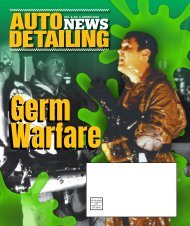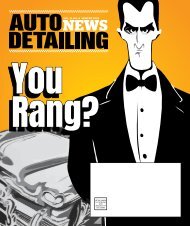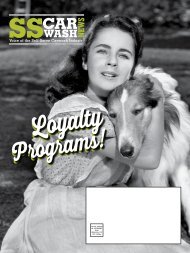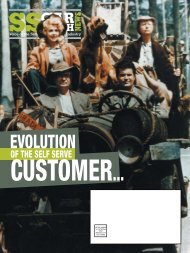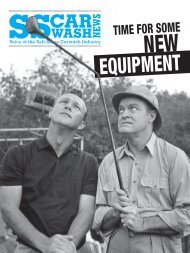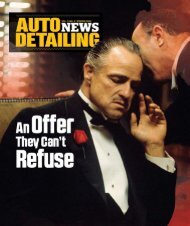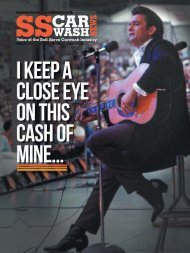You also want an ePaper? Increase the reach of your titles
YUMPU automatically turns print PDFs into web optimized ePapers that Google loves.
QUICK TIPS<br />
MARKETING TIP<br />
Other customers<br />
are out there...<br />
A major benefit of being a self serve owner is that you can usually accommodate<br />
larger and recreation vehicles in your bays. Large trucks, RVs, boats, jet skis, snowmobiles,<br />
and motorcycles are not in-bay automatic or conveyor customers and are ideally<br />
washed inside of a self serve bay.<br />
Knowing this, if you can take in these kinds of vehicles, market the heck out of it!<br />
Put up signs, post on social media, scream it from your rooftops, well, maybe not that.<br />
But getting the message out there is your first challenge when it comes to this side<br />
of the self serve business. Don’t be afraid to dive in though. These things can bring in<br />
big tickets for you.<br />
Also, don’t forget to market your services to business owners who use trucks, and<br />
some of the other aforementioned larger modes of transportation. There are many<br />
vehicles in the fleet world that can’t be washed in an automatic or tunnel wash. Think<br />
about some of the businesses you see driving around your wash. From landscapers, to<br />
box trucks, delivery vehicles, and more, there is a plethora of vehicles out there that<br />
are business based, and need to be able to wash their vehicle, and be able to receive<br />
automated monthly statements instead of individual receipts for every transaction<br />
they do at the wash. This alone brings in big, consistent bucks for you and your wash.<br />
This tip was provided by WashCard Systems.<br />
EQUIPMENT TIP<br />
Protecting your<br />
Perimeter<br />
Cameras that are mounted on the wash structure and looking out at outlying<br />
areas need to be the large type in the traditional outdoor housings. This is for<br />
several reasons. First, since the lighting tends to be dimmer the farther you get<br />
away from the bays, the lens surface area needs to be larger so that the camera<br />
can gather more light. Secondly, the large camera housings are more visible and<br />
tend to be a deterrent to criminals. Color cameras are fine for looking toward<br />
well-lit areas such as vacuum islands, but when pointing the camera toward<br />
darker areas, or when using the camera to pick up license tags, a day/night version<br />
that will switch to a black and white picture is really valuable since it<br />
can see better under dim lighting conditions. Infrared cameras are also a good<br />
choice, especially if it has very bright infrared LEDs to throw the lighting out to<br />
dimly lit areas at night. Pay attention to the distance the specs say that the infrareds<br />
can reach at night. It is a good idea to half this figure to see if the camera<br />
will still give you enough light at the distance you need to see. The distance spec<br />
the camera manufacturer lists, is under ideal conditions on a moonless night. A<br />
bright night or your own perimeter lighting can effectively halve the lighting<br />
distance you will get from an infrared camera.<br />
This tip was writing by Allen Spears, a car wash owner and the chief engineer of Car-<br />
WashCameras.com.<br />
PROPERTY TIP<br />
Sound the Alarm!<br />
The following is a Fire Protection checklist from OSHA (the Occupational<br />
Safety and Health Administration)<br />
FIRE PROTECTION<br />
• Is your local fire department familiar with your facility,<br />
its location and specific hazards?<br />
• If you have a fire alarm system, is it certified as<br />
required and tested annually?<br />
• If you have interior standpipes and valves, are they<br />
inspected regularly?<br />
• If you have outside private fire hydrants, are they<br />
flushed at least once a year and on a routine<br />
preventive maintenance schedule?<br />
• Are fire doors and shutters in good operating<br />
condition?<br />
• Are fire doors and shutters unobstructed and<br />
protected against obstructions, including their<br />
counterweights?<br />
• Are fire door and shutter fusible links in place?<br />
• Are automatic sprinkler system water control valves, air<br />
and water pressure checked periodically as required?<br />
• Is the maintenance of automatic sprinkler systems<br />
assigned to responsible persons or to a sprinkler<br />
contractor?<br />
• Are sprinkler heads protected by metal guards if<br />
exposed to potential physical damage?<br />
• Is proper clearance maintained below sprinkler<br />
heads?<br />
• Are portable fire extinguishers provided in adequate<br />
number and type and mounted in readily accessible<br />
locations?<br />
• Are extinguishers free from obstructions or blockage?<br />
• Are all extinguishers serviced, maintained and tagged<br />
at intervals not to exceed one year?<br />
• Are fire extinguishers recharged regularly with the<br />
noted on the inspection tag?<br />
• “Are fire extinguishers selected and provided for the<br />
types of materials in the areas where they are to be<br />
used?<br />
• Class A - Ordinary combustible material fires.<br />
• Class B - Flammable liquid, gas or grease fires.<br />
• Class C - Energized-electrical equipment fires. “<br />
• Are appropriate fire extinguishers mounted within<br />
75 feet (22.86 meters) of outside areas containing<br />
flammable liquids and within 10 feet (3.048 meters) of<br />
any inside storage area for such materials?<br />
• Are all extinguishers fully charged and in their<br />
designated places?<br />
• Are employees periodically instructed in the use of fire<br />
extinguishers and fire protection procedures?<br />
36 • WINTER 2020



